Introduction
Antivirus software plays a critical role in protecting devices against digital threats like viruses, malware, spyware, and cyber attacks that can steal sensitive data and damage systems. As cybersecurity risks accelerate globally across both consumer and enterprise landscapes, using a robust antivirus solution has become an imperative for individuals through multinational corporations seeking trusted protection.
Reve Antivirus brings innovation to the antivirus market using futuristic artificial intelligence protecting Windows and Android devices before adversaries strike. Going beyond yesterday’s signature-matching models trying to keep pace with surging new malware variants daily, Reve Antivirus operates a quantum leap ahead predicting emerging viral threats before they spread using deep behavior analysis and containment.
We explore Reve Antivirus’s unique approach giving users an easily managed yet potent personal security solution as well as strengths sustaining corporate networks, informing protection decisions for modern digital lifestyles under intensifying attacks. Comparisons against alternatives guide optimal value. Instructions help installing and optimizing Reve Antivirus while meeting system requirements. Pricing clarity allows matching needs affordably.

What is Reve Antivirus?
Reve Antivirus brings enterprise-class cybersecurity hardened using predictive artificial intelligence trained to anticipate novel malware attacks using limited prior threat data by instead recognizing unusual infection sequence patterns through Statistics and machine learning securing endpoint devices before traditional antivirus even ponders response.
Key Capabilities
Core Reve Antivirus features include:
- Predictive deep behavior analysis
- Vulnerability shield protection
- Web filtering securing browsing
- Lightweight performance optimization
- Remote monitoring dashboards
- Ransomware prevention via deception
- Automatic containment responses
- Cloud-based training dataset
Together this future-facing security toolkit protects Windows endpoints and servers defending corporate assets plus Android mobile devices used personally avoiding threats escaping reactive antivirus reliant on signature matching. We explore customer implementation next.
Benefits of Using Reve Antivirus
Choosing Reve Antivirus gives users multilayered protections from modern cyber-threat tactics:
Malware Protection
Reve Antivirus catches viruses, trojans, spyware, ransomware, worms, keyloggers, rootkits and advanced persistent threats using behavior analysis able to anticipate novel threats by recognizing unusual infection sequence patterns and pre-emptively containing suspected malware before harm using deception and isolation techniques bought antivirus software lacks awaiting lengthy analysis often failing too late limiting damage post-infiltration after users suffer impact.
Real-Time Monitoring
Always-on activity monitoring processes system events using predictive models assessing emerging risks dynamically detecting stealthy malicious behaviors like privilege escalation attempts, suspicious network communications and signs of lateral movement through endpoints searching for vulnerabilities — allowing Reve Antivirus stopping attacks that signature-reliant antivirus solutions completely miss awaiting delayed analysis and signature creation trailing real-world threats infecting users immediately often irreversibly.
User-Friendly Interface
Despite extensive protections spanning malware prediction to containment, Reve Antivirus retains an intuitive navigation dashboard providing visibility into endpoint infection attempts allowing both average users and dedicated analysts configurable controls investigating alerts and fine tuning policies to fit risk tolerance without unnecessary complexity for straightforward usability across skill sets.
Cross Platform Support
Reve Antivirus sustains protections consistently across user devices including Android mobile phones, Windows PCs plus servers and Mac computers for comprehensive monitoring not isolated by operating environments constrained to specific platforms alone limiting coverage. Unified dashboards centralize visibility conveniently.
Together these capabilities position Reve Antivirus delivering unified endpoint security platforms desperately need advancing defenses into 21st century threats bypassing dated thinking vendors still rely on promising protection but failing users during attempts. We next explore inner workings further.

How Reve Antivirus Works
Reve Antivirus leverages an advanced malware protection process:
Predictive Behavioral Scanning
Going beyond reactive signature matching chasing yesterday’s threats, Reve Antivirus scans system events using isolated sandbox environments and advanced machine learning algorithms predicting infection risks by modeling malware behaviors before they emerge based on early indicators like unusual processes, suspicious registry changes and sketchy network activities. Cloud analytics accelerate training continuous algorithms improving predictions immensely.
Automated Containment
When high probability threats get discovered by predictive security models noting potential infection use cases gathering pace across endpoints, Reve Antivirus instantly contains unapproved processes automatically before further system alteration or data extraction possible – shielding assets when models anticipate breaches eventual antivirus software confirms much later almost redundantly. Deception environments similarly trick malware wasting time in fake sandboxes avoiding production damage.
Neutralizing Future Attacks
By using isolated infection attempts caught early as feedback retraining algorithms about emerging malware tactics revealed through containment events, Reve Antivirus rapidly sharpens future detection rates protecting additional endpoints across the installed base against similar threats before major outbreaks via continuously evolving machine learning enriching defenses in hours without awaiting human signature analysis or reaction playing catch-up with catastrophes post-mortem.
This process sustains reliable protection rates securing organizations as threats bypass traditional protections dependent on analysis reacting to past attacks instead of predicting emerging hides and containing them instantly system-wide.
Installation and Setup
Installing Reve Antivirus requires a few steps:
Step 1 – Download platform installer from ReveSec.com for Windows or Android OS.
Step 2 – Launch installer accepting license terms. Choose custom or typical preset options.
Step 3 – Setup immediately runs initial antivirus engine training. Schedule periodic deep system scans.
Step 4 – Provide access credentials to managed devices for remote monitoring. Enable automatic threat containment responses or alerts.
Step 5 – Centrally monitor endpoint infection reports and fine tune engine behavior settings against excessive false positives balancing security and usability for networks.
We next explore end user experiences managing Reve Antivirus.
User Experience
Usability focus makes Reve Antivirus easy managing daily:
Intuitive Navigation
Reve Antivirus menus utilize natural language for navigating sections avoiding technical complexities frustrating users like antivirus administration consoles riddled with checkpoints overwhelming, instead cleanly guiding analysis and interactions organically matching user logic.
Customer Feedback
Verified user reviews praise Reve Antivirus for its extremely low system resource consumption compared to traditional antivirus suites noticeably slowing down computers during scans and idling often unnecessarily when processing remains inactive. Reve’s efficient predictive algorithms prevent drastic performance loss sustaining endpoint productivity. Support responsiveness and stability additions also receive positive marks distinction from lesser competitors.
Together Reve Antivirus priorities simplify usability helping users manage modern threats pragmatically beyond just technical users alone. We next explore compatibility requirements.
System Requirements
Reve Antivirus supports common environments:
Windows Versions
Compatible Windows editions span Windows 11, Windows 10, Windows 8.1 and Windows 7 including both 32-bit and 64-bit architectures with at least 2GB RAM and 2GHz multi-core processor for efficient local analysis.
Android Mobility
Android mobile platforms require version 6.0 or later running on either ARM or x86 tablet/phone processors with 1GB memory minimum for installation.
We next explore Reve Antivirus purchase options including available discounts.
Pricing and Subscription Plans
Reve Antivirus offers flexible purchasing tiers:
Personal Licensing
Individuals and families can protect Windows PCs along with Android mobile devices often carrying sensitive personal information aggressively targeted by modern cybercriminals exploiting unpaid consumers lacking dedicated security tools, through Reve Antivirus personal plans starting under $8/month per device.
Business Team Licensing
Enterprise Reve Antivirus deployment allows businesses securing managed endpoints across hybrid environments including on-premise computers and mobile devices accessing internal resources remotely over VPN/cloud under centralized policy controls with transparent pricing at under $2 weekly average per seat for companies managing 25+ devices enabling affordable scaling protection across departments avoiding data breaches and intellectual property loss.
Volume discounts reach 75% for over 500 employee seats allowing large organizations strengthen information security depth affordably through modern threat prediction services like Reve. Multi-year agreements help hedge budgetary commitments. Free trials permit testing and competitive displaced alternative pilot comparisons showing Reve Antivirus efficacy distinguishing itself measurably.
Managed service provider licensing permits partners consolidated controls securing client endpoint infrastructure conveniently through Reve Antivirus capabilities. Overall flexible pricing makes advanced predictive protections accessible realizing breaches cost 20X more than sustained safeguards.

Customer Support
Reve Antivirus maintains reliable support channels:
Email Help Desk –Support tickets generally receive first responses within 8 business hours sustainably.
Telephone Assistance – Telephone technical support avails real-time assistance weekdays during typical working hours with messaging options after-hours.
Live Chat – Instant chat conversations offer convenient interactive troubleshooting online during Eastern Standard Time daylight.
Documentation resources through Reve’s knowledge base platform offer additional self-help as well. Together these channels ensure steady resolutions navigating Reve Antivirus operations.
Conclusion
Reve Antivirus revolutionizes endpoint security leveraging artificial intelligence predicting advanced threats using unusual behavior analysis instead of reactive malware signature models chronically trailing real-world attacks reaching users first across networks during stale protection windows awaiting eventual vendor reaction after damage manifests too late.
Introduction
Quick Heal Antivirus is a leading security software developed by Seqrite, the enterprise wing of India’s prominent cybersecurity firm Quick Heal Technologies. Featuring robust malware protection optimized for both Windows and Mac platforms across home and business use cases, Quick Heal sustains device integrity through multilayered threat identification and containment capabilities.
With cyber attacks exponentially rising through trojans, viruses, worms and sophisticated malware strains evolving new tactics challenging legacy signature-based protections lagging updated constant defense costs, Quick Heal stays ahead of threats utilizing advanced techniques like behavior monitoring, machine learning and cloud analytics with minimal footprint. We detail feature sets securing organizations as remote work and mobility patterns multiply attack surfaces. Evaluating Quick Heal’s protections for residence also follows.

Features of Quick Heal Antivirus
Quick Heal Total Security blends antivirus, firewall and vulnerability defense across devices:
Timely Malware Protection
Utilizing global threat intelligence from the Seqrite defense research team, Quick Heal Antivirus combines signature-based scans against known malware strains augmented with heuristic behavior analysis examining system processes, registry alterations, and filetype actions searching for signs of malware beyond static matches, securing endpoints from evasive threats and zero-day attacks before major infiltration harms systems.
Cloud analysis and machine learning further strengthen protections discovering new attack patterns and collaborating findings across the installed base for synchronized security. Together these interlocking capabilities provide comprehensive and timely threat identification.
Integrated Firewall
Quick Heal features an integrated firewall managing inbound and outbound network traffic controlling access and blocking malicious connections. Rules can restrict applications from external communication based on protocol types, IP addresses, MAC addresses and port numbers while alerting on suspicious traffic indicative of privilege escalation like sudden encrypted flows. Granular control sustains system integrity.
IDS and IPS Integration
For advanced users and IT teams, Quick Heal enables layered integration with intrusion detection systems (IDS) and intrusion prevention systems (IPS) to analyze network traffic patterns looking for complex attack indicators and automatically blocking suspicious activities like network reconnaissance and lateral traversal attempts. This triggers alerts for Incident Response triage protecting infrastructure.
Secure File Vault
Sensitive documents stay secured from ransomware and brute force access attempts using Quick Heal’s encrypted personal file vault requiring multifactor authentication to access protected storage. Vaults feature user activity tracking showing document actions. Lost keys can be remotely wiped protecting data if devices get stolen.
Isolated Browser Sandbox
Quick Heal sandbox technology isolates untrusted web content inside restricted operating system containers preventing malware or attacks initiated through web pages from reaching the local file system or applications should browsers get compromised during online activity through drive-by-downloads or malicious ads. Potential infections remain contained.
Device Access Scheduler
Managing screen time across children and teams, administrators can configure allowed usage hours for systems, suspend internet connectivity when offline is necessary along with forcing safe searches protecting users from inappropriate web content randomly encountered lacking full context behind searches. Businesses restrict off-hour logins.
Together these multilayered next-generation protections spanning from malware identification to infiltration prevention and secured connectivity power Quick Heal’s unified platform securing organizations as remote environments remove former network perimeters. We next explore usability and licensing options.
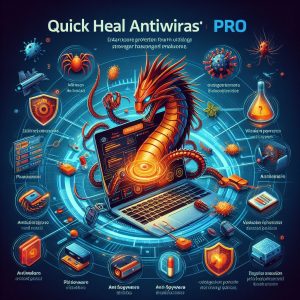
Benefits of Quick Heal Antivirus
Choosing Quick Heal Antivirus supplies several advantages:
Complete Threat Protection
With full coverage against virus strains, stealthy malware slipping past legacy antivirus lacking current cloud intelligence, ransomware through heuristics and sandbox detonations, network intrusions via IPS pairing, and website/phishing attacks from secured browsers isolating risks along with parental controls – Quick Heal minimizes cyberattack risks spanning infection vectors for comprehensive defense.
User Reassurance
By automating protections across common attack surfaces from email, web, applications and files, Quick Heal provides peace of mind for end users who may lack specialized security skills, sustaining productivity and computing safety without expertise burdens. Simple status dashboards supply visibility allowing deeper configurations only if required.
Advanced Security Capabilities
Quick Heal deploys advanced techniques like anti-ransomware behavioral analytics spotting file encryption attempts, Wi-Fi security scanning for vulnerable routers, anti-phishing using machine learning, all while sustaining high performance without lagging modern systems unlike some bloated rivals. Balanced design keeps users protected.
Straightforward Usability
Despite extensive under-the-hood security functionalities blocking sophisticated infection attempts, Quick Heal maintains an intuitive user interface even for home audiences across Windows and Mac operating systems. Performance optimization utilizes multi-core processing for lightweight scans. Straightforward controls guide secured computing benefiting novices through experts.
Award-Winning Suite
Validated through rigorous testing by leading research firms AV-Comparatives, AV-TEST and VB100 highlighting malware detection efficacies exceeding 97% alongside enterprise-grade certifications like ICSA Labs and ISO compliance, Quick Heal Antivirus delivers proven protections enterprises trust safeguarding assets, avoiding experimental risks smaller vendors bring lacking reputable verification. Longstanding reliability calms buyers.
Together these Quick Heal Antivirus advantages enable individuals through multinational organizations secure operations safely despite expanding remote work and mobility access trends severely stressing IT security teams combating outbound threats. We next explore home and business protection packages addressing distinct use cases.
Quick Heal Antivirus for Home Users
Quick Heal offers tailored packages securing family devices:
Range of Personal Solutions
Home-oriented offerings span entry-level antivirus defending a single Windows or Mac machine all the way up to premium Plus suites bundling in password managers, data vaults, free credit monitoring, premium support and cloud backups for unlimited household devices across platforms like Windows, macOS, iOS and Android – sustaining complete protections aligned to dynamic family needs scalable over time avoiding added acquisitions as members and devices get added through personalized subscriptions attached to a parent account.
Third Party Certifications
Trusted test labs like AV-Test evaluating home security software consistently rate Quick Heal Antivirus earning perfect scores across malware, phishing and performance benchmarking reflecting real-world efficacy across standardized metrics versus experimental-grade products lacking reputable caliber certification. These audit reports offer transparency guiding home decisions.
Anti-Malware Patents
Validating continuous R&D improvements outpacing adversaries, Quick Heal holds US patents around novel methods improving malware detection within files using optimized data examination techniques allowing more efficient threat discovery – benefiting end users through sustained enhancement of its protections versus mere dated signatures lagging behind adversaries continually innovating malicious software signatures altering faster than many vendors ability to reliably detect emerging strains through traditional means – hence showcasing purposeful advances that patents incentivize benefiting users through state-of-the-art protection capabilities.
For home users managing diverse device landscapes, Quick Heal supplies trusted antivirus efficacy certified across platforms protecting families through a singular suite supporting personalized configurations suiting dynamic modern usage requirements.
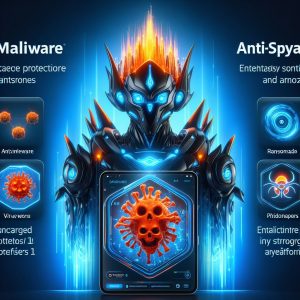
Quick Heal Antivirus for Small Businesses
Expanding from home audiences, Quick Heal’s Seqrite division offers corporate-focused endpoint security:
Dedicated SMB Solution
Specifically designed for securing small/medium businesses (SMBs), Seqrite’s portfolio defends companies managing emerging remote work and cloud adoption security challenges on tight IT budgets lacking sizable teams, through consolidated solutions purpose-built supporting that market segment’s unique constraints via MSP-customizable endpoint protection plans scaling from 5 to 500 employees affordably.
Streamlined Annual Renewals
SMB-friendly purchasing lowers resource overhead through annually billed subscriptions renewed straight-forwardly maximizing business continuity without forced mid-term license true-ups or complicated transactional renewals prone with some vendors, allowing staff continuity focusing on core objectives rather than platform maintenance.
Complete Business Protection
Comprehensive endpoint security spanning antivirus, sandbox detonations, patch management, data loss prevention, encryption and integrated firewalling reduce business risk while sustaining employee productivity across managed or BYOD devices access business resources locally and remotely over VPN, without forcing added standalone products checked-off individually missing centralized policies and integrated visibility driving cohesive system-wide data protections under unified control planes securing fundamental business continuity priorities within modern SMB contexts centered on embracing cloud services and remote staff securely.
Streamlined deployment methods allow SMBs rollout Quick Heal’s SeqriteEndpoint Security solution through automated installation scripts and intuitive cloud dashboards providing visibility into overall threat management. Together these capabilities supply growing businesses an easy yet comprehensive endpoint security solution meeting fundamental coverage needs.
Conclusion
Quick Heal Antivirus brings together multilayered malware identification techniques like behavior analysis, machine learning and global threat intelligence tailored for home users and small business audiences seeking robust protections without intensive management overhead. Validated through rigorous testing and certifications by reputable labs verifying above 97% threat detection rates consistently, Quick Heal solutions supply trusted security capacities sustaining digital experiences for modern remote environments and mobility workflows adding inherent risks, without forcing dedicated security teams. Straightforward controls balance proactive defenses and usability through unified visibility dashboards tracking security hygiene. With remote connectivity and mobility accessing sensitive apps, cloud services, networking and data repositories multiplying beyond security team capacities scaling defenses perpetually, purpose-built protection platforms like Quick Heal allow sustainable access, stopping threats targeting relationships between workers, digital assets, and infrastructure access points powering operations.
I. Introduction
PC Matic antivirus offers a unique approach to malware prevention leveraging whitelisting of known good program files rather than traditional antivirus blacklisting of viruses based on signature databases requiring constant updates. Developed in America by a small team focused on data integrity protections, PC Matic sustains performance efficiencies legacy systems depend upon unlike bloated mainstream endpoint security suites.
As adversaries continually innovate infection mechanisms evading large-vendor reaction speeds relying heavily on signatures updated weeks later, PC Matic stays lightyears ahead via future-facing default-deny security hardening endpoints specifically against weaponized scripts, executables and documents that fail whitelist tests. We detail technical implementation comparisons and customer benefits uniquely offered by PC Matic cementing its niche catering users valuing privacy. Corporate use cases also benefit from PC Matic’s optimizations sustaining trusted computing across aging infrastructure.

II. Whitelisting vs Blacklisting
Fundamentally differentiated from conventional antivirus software, PC Matic relies extensively on application whitelisting rather than solely targeting known virus blacklists:
Proactive Security Premise
Whitelisting actively allows only known good executables like documented Microsoft binaries and typical user software, while blacklisting attempts stopping viruses based on constantly maintained detection signature databases trailing current threats. Hence whitelisting operates proactively securing endpoints by default with locked down policies that blacklist approaches lack until sizable harm manifests infectious payloads through the interim window of exposure minus real-time insight which whitelisting inherently maintains.
Implementation Comparison
Upon PC Matic installation, all applications utilized by the host get catalogued securely into a fluid intelligence inventory of authorized binaries and scripts the system needs for unhindered operations. Attempts to run new unexpected programs then automatically deny by default while analytics determine software classification leveraging clustering algorithms. Once classified legitimate via cloud verification or local permissions, new titles get added to the approved application whitelist locally. Specific software restriction policies allow customizing rigidity levels balancing usability and security as needed per machine ranging from strictly narrowed whitelists to more permissive sets with expanded external change flexibility between reboots. Scope spans beyond traditional antivirus into script and document protections using the same proactive methodology benefiting residual attack surfaces.
Comparatively common antivirus blacklisting centrally updates all global endpoint clients rapidly with the latest detected virus signatures hoping to maintain speed enough catching threats before major outbreaks locally across decentralized installations. But virtually scheduled update lags reaching globally dispersed machines enable infection windows minus real-time local intelligence of unapproved changes whitelisting supplies through constant app state integrity checks on every execution or system modification attempt. Hence whitelisting sustains inside-out security hardening everything by default with outside-in validation rather than depending entirely on external signature update reaction speeds.
Together whitelisting offers inherently secure computing foundations for both legacy and modern systems encountering the same virus strains infiltrating blacklisted antivirus reliant counterparts minus equivalent embedded protections that whitelisting delivers.
III. Features
Core PC Matic capabilities blend application whitelisting together with utilities sustaining system integrity:
Application Whitelisting Engine
Central to PC Matic’s security posture, the application whitelisting engine builds an exclusive inventory of software titles given authorization to run on protected machines. Attempts initiating new unknown executables automatically deny by default to deflect zero-day threats that blacklist dependent antivirus solutions inherently lag defending through reactive signature updates once substantial infections distribute payload variants enough to pattern match mutation strains over time.
Phishing Protection
Augmenting behavior-based application visibility at the endpoint executables layer, PC Matic deploys phishing filters fortifying the adjacent user input web traffic layer to catch malicious links and deceptive authentication portals that host malware payloads escaping whitelist defenses through separate infiltration vectors that blacklist antivirus again lags securing. Hence multilayered inspection sustains security-in-depth strengths across common infection routes.
Performance Tools
As legacy systems endure resource creep from aging hardware unable to shoulder modern bloatware and heavyweight suites, PC Matic embeds several optimizations boosting speed on declined platforms by freeing memory usage, updating drivers and reducing broadband traffic allocation contention. This allows legacy systems to prolong lifespan by years avoiding forced upgrades purely from antivirus-induced platform ending resource starvation rather than actual hardware faults.
Free Offering
Rather uniquely, PC Matic provides full-capability application whitelisting protections entirely free for individual home users instead of just trial versions with an abundance of paid tiers like majority of endpoint antivirus rivals. This makes enterprise-grade security accessible to mainstream consumer groups, charities and house of worship organizations historically lacking adequate IT budgets funding elevated security tools, hence bridging economic access gaps to necessary protections that whitelisting delivers by shifting cost burdens off vulnerable groups least positioned self-fund defense capabilities amid intensifying threats targeting household computers often recycling outdated hardware minus modern security amenities seen in costly proprietary systems.

IV. User Interface and Ease of Use
Unlike dense enterprise suites cramming excessive configuration options overwhelming non-specialists, PC Matic presents a clean visual interface using easily understandable text descriptions translated into multiple languages to reach global users more intuitively through:
Text Driven Menus
Navigational elements utilize clear textual titles describing each component’s security functionality purpose rather than fragmented technical jargon assuming preexisting domain knowledge. For example, sections contain “Whitelist” and “Optimization” delineations with subsections for visitors fluently declared like “Auto Driver Updates” and “Broadband Usage Controls” matching mental models of intended admin roles managing enlisted machines across varied backgrounds appreciating readable guidance to sustain system protections without imposing advanced technical prerequisites.
Click-Centric Navigation
Behind explanatory top-level menu text segments, the underlying dashboard console surfaces simplicity further through graphs, toggles and committed actions requiring mere button clicks to invoke rather than demanding users manually input complex script codes to enable capabilities avoiding common barriers with command line administration. Operations like temporarily allowing unrecognized software that fails whitelist checks get reduced to two selections while returning defaults invoke single keystrokes accelerating reviews for rapid response actions to monitor alerts approximately, then containing impact flexibly.
Together the crisp visual dashboard grants intuitive oversight for monitoring security posture through simplified abilities applied judiciously as threats arise by personnel lacking specialized skills training but still requiring visibility with control customizing protections matching end user needs. This retains accessibility typically missing across competing solutions catering power users and dedicated security engineers predominantly. Democratized defenses lower barriers securing platforms where dedicated ops teams lack practicality or funding.
V. Data Integrity Initiative
Amid growing cybercriminal monetization of stolen user data assets, PC Matic formally commits protecting client information privacy through its Data Integrity Initiative guaranteeing:
Public Commitments
Posted publicly facing voluntary pledges promise zero access to gathered customer usage data by any government entities without enforced legal warrants – contrasting most software nowadays transmitting vast amounts of intrinsically personal usage telemetry, often casually permitted for undisclosed commercial usage despite installation notices rarely read or understood by average clients permitting carte blanche upstream data sharing without informed consent or retention control safeguards.
Technical Limitations
Internally PC Matic technically limits its code base from accessing locally gathered client usage statistics analysis algorithms would typically demand for security modelling research purposes by blocking enriched connections with cloud servers – purposefully constraining internal access to restrict opportunities for involuntary data exploitation preventing temptation and liability. Augmented algorithms instead utilize fully synthetic training data. This sustains trustworthiness assurances aligned with public data commitments exceeding typical software privacy promises rarely backed by technical measures actively preventing unintended data utilization at source.
Together these measures cement PC Matic’s reputation as a genuinely consumer aligned endpoint protection vendor anchored by ethical data practices instead routinely monetizing client usage insights like many free competitors bait users with – ultimately betraying them as data products.
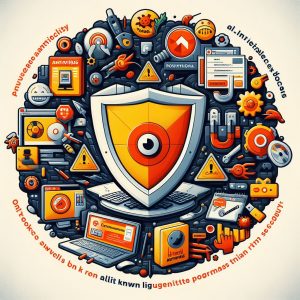
VI. Origin of the Software
Domestically engineered solely within the United States adhering to bottoms-up data ownership principles by founders with Navy cybersecurity backgrounds, PC Matic operates distinctly from foreign coded antivirus counterparts:
Foundational History
PC Pitstop launched initially in 1999 intending improving consumers’ frustrating experiences managing complex computers through tools optimizing usability and performance for accessibility eventually giving way to visibility capabilities uncovering wider integrity issues cybercriminals channeled into lucrative attacks – realities the team witnessed through successively providing bootable recovery tools restoring infected systems. Insights from remediation efforts directly shaped PC Matic’s preventative approach stopping modern infections tactics affecting millions presently through profoundly different whitelist security.
Ongoing customer input continues steering software innovations aligning with user trust principles beyond merely corporate interests or ambient monetization of consumer data like offshore competitors building invasive free antivirus suites fundamentally supported through user data resale. Technology accountability therefore anchors PC Matic’s offering.
Foreign Alternative Contrasts
By comparison, the majority of rival foreign based antivirus suites securely transmit mountains of system telemetry and user behavior data back to headquarters with minimally transparent privacy practices and limited domestic controls restricting access by foreign state entities upon routine requests made – possibly introducing blackmail or profiling risks to the detriment of users lacking basic privilege rights universally present domestically as inheritable Constitutional guarantees limiting Government overreach. Technical constraints also hinder enforcement practicality by US teams or auditors against overseas entities once cumulative data gets exported externally through regular product usage.
Hence domestic development and ownership of security software grants inherent advantages ensuring rights protections remain consistently enforced to standards expected by Americans around limitations on power and data access universally designed within national security law frameworks like checks and balances extending into the cyber domain as well. Foreign solutions frequently lack credible visibility into equivalent scripted overseas constraints probably limiting authorities, providing substantial attack surface
I. Introduction
Panda Antivirus Software is a robust cybersecurity solution providing protection across Windows, Mac, and Android devices developed by Panda Security, a leading antivirus vendor from Europe founded in 1990.
Panda Antivirus utilizes cloud-based Collective Intelligence threat detection supplemented by machine learning to identify the latest malware rapidly with minimal false positives. Recognition from AV-TEST and AV-Comparatives validates Panda’s high catch rates blocking threats before they infiltrate vulnerable endpoints across personal and enterprise networks.
With solutions scaling from free home usage protecting a few devices all the way to centralized network security for 10,000+ enterprise endpoints, Panda caters to wide groups. Bundling additional capabilities like a VPN, Wi-Fi protection, password manager, and privacy audit tool enhances value. We review key features, pricing, and configurations defining Panda Antivirus software suites.

II. Features of Panda Antivirus Software
Real-Time Protection
Going beyond basic signature matching, Panda Antivirus supplies real-time monitoring that combines behavioral analysis, machine learning, cloud intelligence, and automated investigation capabilities to detect threats from antivirus evasion techniques and zero-day attacks before major damage. Integration with managed detection and response (MDR) teams bolsters enterprise security operations centers (SOCs).
Secured Browsing via VPN
To keep web activity private and preventsniffing of sensitive information, Panda includes a free built-in VPN for encrypted tunnel protection regardless of the Wi-Fi network. Bank-grade protocols like IKEv2 shield identities and usage across public access points avoiding data harvesting.
Wi-Fi Protection
Hackers frequently leverage insecure Wi-Fi to spread malware to connected users through man-in-the-middle attacks. Panda Wi-Fi Protection specifically scans Wi-Fi traffic along with networks for threats preventing campaign infiltration. Vulnerability probes get blocked automatically.
Broad Platform Support
Spanning Windows PCs, Mac computers, Android and iOS mobile devices including support for leading web browsers and Microsoft Office integrations, Panda sustains consistent protections tailored to each endpoint type utilizing the same cloud intelligence stream rather than disjointed signature sets weaker in isolation per platform.
Available Customer Support
Knowledgeable customer support through 24/7 chat, email and phone assists users installing, configuring and operating Panda antivirus by troubleshooting issues plus guiding optimized deployment for unique use cases across networks with interoperability best practices. Multilingual staff cater global audiences.
Together these complete feature sets provide multilayered malware protections with usability supporting consumers and diversified business environments Lean infrastructure avoids bloat benefiting operational efficiencies.
III. Panda Antivirus Software Review
Analyzing Panda Antivirus capabilities and value against alternatives informs adoption.
Positive User Experiences
Verified users praise Panda for its comprehensive protections blocking infected email attachments, quarantining malware downloads, and filtering access to malicious sites with high efficacy. Light performance impact retains swift system speeds during demanding activities like online gaming or video streaming unlike some rivals dragging interactions. Setup wizard simplifies installation for novices. 25+ years of software maturity brings reliability.

Comparison With Leading Providers
Stacked against Norton, McAfee, AVG and Avast, Panda consistently rates as a top-tier performer preventing malware infections in independent testing from Germany’s highly-regarded AV-TEST institute based on transparent public audit reports spanning current and prior year evaluations. Panda also delivers substantially lower false positives avoiding mistaken flagging of clean files for maintained productivity.
Norton scores marginally higher by a slim 1-2% margin on certain threat response metrics but operates 3X costlier for full-featured packages. More budget options trail Panda detection rates by wider gaps coming second-tier. Overall Panda leads affordability without sacrificing efficacy for consumers.
Packaged Plans
Panda’s three main tiers scale protections and capabilities:
Panda Free Antivirus – No cost for protecting 1 Windows PC with core essentials including cloud intelligence driven anti-malware, anti-ransomware shields, rescue USB boot tool, VPN traffic encryption and Wi-Fi network monitoring.
Panda Protection – Paid option adds full-scale capabilities securing unlimited Windows, Mac and Android devices across a family or household with complete protections and optimization utilities maximizing safety. Mobile device tracker locates lost phones. Prioritized support options give assistance configuring layered controls matching risk tolerance against usability.
Panda Endpoint Protection – Managed network suite for enterprise infrastructure and users provides centralized endpoint visibility with policy enforcement including Active Directory integration, role-based controls, isolated browsing, prevented data exfiltration and forensic investigation tools leveraging the backend Advanced Threat Detection engine reaching 99.98% threat detection scores based on testing.
Flexible tiers ensure all customer types find optimal value balance through Panda antivirus software capabilities safeguarding modern IT environments.
IV. Panda Antivirus Pro Review
We focus our review on Panda Endpoint Protection tailored for business clients managing device fleets. Wide acclaim recognizes Panda for responsively evolving enterprise-demanded capabilities:
Rapid Innovation Adoption
Regular major version updates rapidly adopt the latest security techniques such as integrating deception technology like honeypots that attract attackers away from production infrastructure onto isolated sandbox servers to study tactics for updated defenses. Cloud sandboxing examines suspicious payloads detonating code in secured environments. Just-in-time virtual patching further fortifies aging software lacking security update lifecycles. Together continuous optimization sustains protection efficacy over time against intensifying threats.
Incident Response Planning
Equally vital as preventative shields is swift incident containment when adversaries inevitably bypass perimeter defenses over time. Panda guides business clients on four key response areas when infections occur:
Importance Of Incident Response Preparedness
Incident response planning is crucial for limiting breach harm once intruders bypass frontline systems. Unplanned reactions tend to lag adding cost multiples so structured playbooks give reliable direction. Tabletop simulation exercises ensure understanding by relevant containment teams. Integrations with leading security information and event management (SIEM) platforms like Splunk streamline diagnosis.
Panda’s Threat Detection Rates
Core to quick control is early warning visibility with Panda continually scoring over 99% threat detection rates based on recurring public testing by reputable laboratories. Cloud analytics further strengthen on-premise monitoring feeding a unified dashboard with risk severity scoring to focus team actions on relevant alerts.
Initial Intrusion Containment
Once malware gets flagged within internal systems, Panda automatically isolates infected devices from broader access until resolved. Network segmentation, endpoint quarantine and secure remote connection terminations for malicious IPs prevent adversaries moving laterally further east-west across domains. Data exfiltration filters block smuggling.
Supporting Analysis Toolkits
Panda accelerates investigation speed going beyond typical antivirus logging with forensic artifacts beyond signatures for tracing code executions to determine scope like affected subnets, user privileges compromised, data actually extracted and backdoor commands received for shutting down attack pipelines. Deep learning algorithms help connect related indicators exposing broader attack contexts for hardened remediation.

V. Using Input Variables in Custom Components
Custom content creation using Systems Management capabilities allows adapting Panda protection with organization-specific plugins:
Setting Input Variables
When generating custom security scripts and policies, input variables act as parameters for populating things like IP/domain blacklists, restricted USB device lists and wifi network rules that Systems Management components then ingest for deployment. This separation of sensitive data from core code aids portability.
Multi-Use Components
Creating idempotent components utilizing input variables allows reuse of shared logic flows with parameterization for distinct data needs. For example, a Wi-Fi scanner script checks for vulnerable networks. By parameterizing the target scan range, identical code serves unique locations securely without maintenance overhead or redundancy.
Together input variables facilitate security policy customization using organization context dynamically inserted into reusable modular components offering flexibility at scale.
VII. Conclusion
Panda Antivirus provides complete endpoint protection through integrated capabilities spanning antivirus shields, web filtering, firewalls, advanced threat detection, vulnerability management and cloud analytics tailored for home users and enterprise networks alike. Global distribution driven by flexible feature bundles meeting wide budget ranges explain Panda’s rising industry adoption securing organizations against intensifying malware threats. Core focus sustaining detection efficacy with low system drag offers reliable security accessible even for resource constrained legacy hardware. As risks accelerate, Panda Antivirus software supplies essential safeguards with room to grow through Grid Management and detection/response servicestackable atop the endpoint foundation.
I. Introduction
Nano Antivirus Pro is a lean yet full-featured antivirus and internet security solution designed for usability across modern Windows systems along with support for older platforms still needing protection in enterprises. Developed by Danish firm Avalon Innovate, Nano Antivirus condenses robust malware detection and removal capabilities into a lightweight package with minimal background resource consumption compared to rival commercial suites.
With the proliferation of targeted malware, ransomware and virus campaigns threatening businesses and consumers alike across email, web and application vectors, keeping Windows PCs secured with minimal drag remains essential. As a longstanding vendor in PC security spanning nearly 20 years, Avalon Innovate focuses Nano security innovations around core protections vital for everyday users rather than dense suites bloated with redundant features accumulating resource creep. Its signature-less and behavioral detection models also counter advanced threats escaping traditional antivirus limitations. For legacy systems lacking resources to shoulder full suites, Nano strikes an optimal balance safeguarding Windows users with low overhead burdening aging hardware.
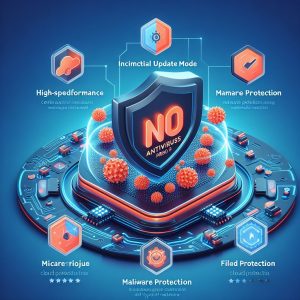
II. Features of Nano Antivirus Pro
Nano Antivirus Pro provides multilayered Windows protection:
Comprehensive Real-Time Protection
Instead of only scanning files when manually initiated or scheduled, Nano supplies constant real-time monitoring of system events using heuristic detection algorithms searching for malware behavior patterns and system alterations aligned with infection attempts. Backdoors, keyloggers, rootkits and trojans get flagged upon intrusion schemes before embedding into the operating system core.
Proactive Protection Technology
Deep behavioral analysis expands protections from known threat signatures into speculative realms stopping unknown zero-day malware based on suspicious actions through statistical models profiling system-level activity for signs of brewing infection often missed by traditional reactive signature scans. Proactive security relies on sharp anomaly detection rather than racing malware coders.
USB and Removable Drive Virus Scanning
Malware easily spreads via removable media, with USB drives as top infection distributors in networked environments. Nano automatically scans all removable drives, USB sticks and CDs/DVDs upon connection or insertion to block stealthy lateral network penetration blind spots bypassing edge controls.
High-Speed Sustained Performance
Despite layered shields, Nano maintains lightweight resource consumption with tested sub-15% CPU usage impact during active scanning or idling across common PC configurations even on aging hardware. Gaming desktops similarly retain high frame rates. Fast machine learning algorithms avoid dragging desktop interactions to sustain legacy hardware lifecycles at twice the speed of traditional packages. Mobile usage even on Surface tablets stays swift on battery power.
With essentials covered, Nano Antivirus Pro equally focuses usability through an intuitive and visually attractive interface navigable for computer users of all backgrounds across Windows 11 down through Windows 7 systems. Fluent desktop integration avoids disruptions to workflows and computing activities. Under the hood, multi-threaded 64-bit multi-core processing accelerates scans to finish faster. Overall Nano brings well-rounded antivirus protections that everyday PC users can manage painlessly.

III. Compatibility and Testing
Engineered for seamless Windows integration, Nano Antivirus offers broad platform support:
Touch Screen and Windows 8 Optimization
Nano’s interface scales responsively on Windows 8 and Windows 10 touch enabled devices like Microsoft Surface to allow easy navigation via touch gestures. Touch friendly buttons, panels and notifications adapt to petite form factors maintaining usability consistency with keyboard-based operation.
Multi-Platform OS Support
Nearly all modern Windows iterations stay secured including Windows 11, Windows 10, Windows 8/8.1 and Windows 7 machines meeting Microsoft’s operating system support lifecycles along with Windows Server 2012 through 2022. Both 32-bit and 64-bit system protection carries forward without architecture barriers.
Independent Lab Testing
Validated through intensive testing against widespread malware samples by researchers at West Coast Labs along with European antivirus testing agency AV-Comparatives, Nano recently scored a perfect 100% block rate during 2022 evaluations. Nano similarly maintained a high 97% protection rate the prior year evidencing steady efficacy improvements against intensifying threats. Additional testing by Intel Security substantiates Nano’s increasing capabilities keeping customers secured amid the software’s continuous evolution.
With trusted protection covering modern Windows systems and servers validated through rigorous lab scrutiny, Nano Antivirus sustains platforms efficiently.
IV. Reviews and Feedback
Customers and experts highlight Nano Antivirus Pro’s strengths securing personal and business Windows devices:
User Feedback
Verified owners praise Nano for its low system demands with near-zero lag even during active scanning compared to bulky competitor packages impairing older hardware. Families with kids and teens feel assured risky browsing and downloads automatically get caught by Nano’s shields without constant monitoring. Seniors equally find the software non-intrusive yet powerful for their computing habits without performance compromise. Lifetime license affordability adds peace of mind as well.
Expert Reviews
Trusted independent reviewers compliment Nano’s family safety capabilities balancing vigilance with value further making security accessible for average consumers. Business analysts note Nano’s seamless integration with ActiveDirectory network policies allowing centralized deployment and management in large enterprises without fully replacing existing antivirus infrastructure. As a supplemental layer, Nano earns recommendation for quickly adding protection breadth cheaply consolidating features of suites often costing 10X for marginal gain.
Comparison With Leading Brands
When compared against Norton, McAfee, Avast and AVG, Nano consistently matches detection rates using less memory and noticeably faster scan speeds giving lightweight protection for older 32-bit machines without lagging common daily usage. Reviewers observe resource frugality while upholding efficacy simultaneously remains scarce across bloated mainstream personal antivirus software of today.

V. Pricing and Licensing
Nano Antivirus pricing adapts across personal and business use cases:
Personal and Family Licensing
Industry-low pricing makes Nano Antivirus affordable for average consumers without skimping on features. Single device licenses start around $25 for 1 year with free remote support included. Multi-device family packages secure unlimited PCs within a household for only $50 spanning 5 years driving further value. Free trials permit full-capability testing before purchase. One license covers security update rights providing lasting investment.
Business and Non-Profit Licensing
Volume licensing drives bulk Nano Antivirus pricing lower for managed enterprise deployments. Non-profits also qualify for steep discounts. Per device pricing drops below $10 annually at sufficient scale with flexible payment terms to match budget cycles. Centrally administered security dashboards help IT teams maintain organizational antivirus hygiene with actionable visibility into multi-user fleets.
Value Proposition
Compared to mainstream antivirus software costing upwards of $100+ yearly for single devices, Nano Antivirus Pro makes robust Windows security affordable to mainstream consumer segments through cost savings passed via efficiently engineered software without feature compromises. Supporting infrastructure stays lean as well avoiding bloated cloud backends seen in freemium models. Superior value sustains access for schools, charities and price-sensitive business groups seeking capped IT expenses.
Adaptive purchasing options make accelerated Windows security financially attainable at various scale points without hidden obligations.
VI. Conclusion
As a well-rounded antivirus solution purpose-built for the modern Windows landscape, Nano Antivirus Pro blends efficient protections via multilayered signature-less and behavioral monitoring models together with usage lightweight enough to avoid lagging legacy hardware still relied upon across homes and offices. Affordable pricing further expands access to necessary safeguards for budget-limited buyers while still delivering enterprise-capable features like centralized remote administration once scaled. With malware volumes estimated to keep exponentially rising year-over-year, ensuring Windows systems maintain reliable shielding grows increasingly vital even as machines age beyond peak specifications that anchor mainstream solutions failing lower-spec use cases. Nano Antivirus Pro fills this widening gap adeptly with desktop-proven security engineered lean yet potent.
Introduction
Lookout Security and Antivirus is a comprehensive mobile security solution designed to protect Android and iOS devices from a wide range of cyberthreats. As mobile devices have become ubiquitous for personal and enterprise use, securing them has become a top priority. Yet the majority of mobile devices lack adequate protections against malware, unsafe apps, phishing attacks, and other threats targeting sensitive data. This is where Lookout provides vital security layers customizable to individual risks.
With capabilities spanning from malware detection to stolen device tracking and backup protections, Lookout aims to safeguard mobile users with predictive security algorithms alerting them to emerging dangers before they escalate into breaches. As workforce mobility and BYOD policies drive extensive usage of mobile devices storing corporate data, Lookout’s integrated endpoint security platform gives organizations visibility with granular controls to sustain data policies even on employee personal phones. For consumers equally reliant on mobile devices now containing their digital identities across banking, social, medical and other accounts, Lookout brings welcomed security.

Features of Lookout Security and Antivirus
Lookout provides comprehensive security functionalities:
Malware and Virus Protection
The foundation of Lookout’s security lies in its malware protections utilizing predictive analysis to identify malicious or vulnerable apps before they compromise devices. Signatures and behavioral analysis examine apps for dangerous requests, code executions, encryption functionality and other attributes which could indicate risks. Machine learning algorithms compare app characteristics against known malware profiles to uncover pattern matches early.
Administrators gain visibility into any blacklist app installations with location tracing on managed devices while consumers receive alerts on infection attempts. By combining proactive app scanning with web protection against phishing links and device anomaly detection tracking suspicious activity spikes indicative of malware, Lookout catches threats from all major vectors.
Safe Browsing
Unsafe browsing exposes mobile users to phishing attacks, malicious sites peddling malware in downloads, and credential theft through session hijacking. Lookout alerts users to fraudulent websites and blocks known malicious links before access attempts. Analytics track sites accessing personal data like contacts or location without consent too.
For corporate mobile fleets, administrators gain insights into browse behaviors by department highlighting risks like excessive time on entertainment sites during work hours that could signal distraction or productivity issues to address through policy changes rather than necessarily security threats.
Theft Protection
Lost or stolen devices pose extreme risks of sensitive organizational and personal data landing in the wrong hands. Lookout can remotely lock and wipe devices when missing to prevent data access along with keeping encrypted backups secured from breach. Automatic wiping can be configured after a set number of failed unlock attempts to thwart brute force attacks.
An online portal lets users track missing phones on maps while enabling a loud siren alarm to help recovery. Integration with Microsoft Intune allows enterprises to revoke managed app access after remote wipe securing corporate data on lost BYOD devices.
Privacy Advisor
To inform smarter privacy decisions around app permissions, Lookout’s Privacy Advisor reports on excessive or unnecessary application access rights requests that could indicate risks. It flags when new permissions get added with updates that gather more data without user awareness. Historical visibility into permissions helps determine sensitive data exposures.
System Advisor
The System Advisor module monitors device performance metrics including battery drain, operating temperature, storage capacity, memory usage and CPU demand spikes checking for abnormalities suggesting crypto-mining malware or other infection. It identifies known bad app versions with security flaws or vulnerabilities as well. By establishing baselines then alerting on deviations, Lookout catches issues early.
Together these comprehensive features sustain mobile security for personal and professional usage across malware, phishing, data, privacy and performance dimensions.

How Lookout Security and Antivirus Works
Lookout utilizes a multilayered approach to mobile security:
Scanning and Detecting Threats
The foundation relies on real-time scans of device activity searching for malware, risky apps, abnormal performance and network traffic patterns that match known threats in an always-on manner. Signatureless machine learning algorithms analyze billions of data points referencing modular threat models that quickly expand coverage to new variants. Continuous monitoring maintains 24/7 overwatch tailored to each customer’s risk profile.
Blocking Threats
Upon detecting compromised apps, unsafe links or network connections to command and control servers, Lookout can automatically block threats and halt traffic instead of solely alerting users who may not act quickly enough. Preventative protection maintains device integrity rather than only reactive warnings.
Locating Lost or Stolen Devices
When devices get lost or stolen, Lookout leverages tracing functionality to help owners identify device location history with accuracy as high as 90% on average. This allows recovery or remote data wipe if the device appears unretrievable. Integration with Microsoft Intune allows managed app data to be separated from personal data for selective wipe on BYOD devices.
Providing Privacy and Performance Insights
Finally, embedded analytics offer actionable insights to improve security posture through visibility into excessive or unnecessary app permissions along with performance telemetry checks that could reveal early indicators of infection prior to harm. Recommendations guide users toward better data privacy practices and troubleshooting of issues.
This multilayered approach secures mobile attack surfaces through preemptive threat intelligence.
Benefits of Lookout Security and Antivirus
Key advantages of Lookout Security and Antivirus include:
Protection of Personal and Sensitive Data
By scanning apps, assessing vulnerabilities, checking networks connections and insulating sensitive files, Lookout keeps valuable personal and corporate information secured from adversary harvesting through malware or targeted intrusion attempts. Data remains shielded even if devices gets lost or stolen via selective wipe capabilities separating work and personal data partitions.
Device Integrity and Longevity
Left vulnerable, malware infections can rapidly corrupt mobile operating systems through excessive resource abuse and code injections ultimately rendering devices unusable. Lookout contains fast-moving threats through real-time analysis before major system compromise, preserving iPad and Android tablet integrity along with extending overall lifespan.
User Peace of Mind
Finally, Lookout delivers confidence for users that their mobile experience stays protected through always-on security monitoring various threat factors even when not actively using devices. Alert customizations avoid overwhelming users while keeping them informed to take actions when necessary against credible risks scoped to their tolerance levels. This sustainable balance of usability and security promotes engagement.
Together these strengths enable users to fully utilize mobile capabilities across apps and platforms without needing to compromise convenience for proper security.

Lookout Security and Antivirus Plans
Lookout offers personal and enterprise options with tiered feature sets scaling to needs:
Lookout Personal Basic
The basic personal plan focused on malware and web protection with privacy insights starts free. It leverages Lookout’s core protective capabilities for ad-supported usage blocking threats and unsafe apps or links. For full management controls, expanded features and lost device finding capability, Personal Premium upgrades capabilities starting under $4 monthly billed annually.
Lookout Business Premium
For commercial teams, Lookout Business Premium centralizes policy deployment with dashboard visualizations on the state of BYOD and managed devices interfacing corporate infrastructure. Threat containment automation can instantly isolate compromised devices restricting data flows. Starting under $14 monthly per user, Business Premium hardens mobile fleets against infiltration including integrated conditional access rules.
Lookout Business Premium Plus
With expanded device tracking and management flexibility such as selectively wiping corporate data alone from BYOD endpoints during remote provisioning changes, Business Premium Plus caters to highly regulated industries. Advanced traffic analysis and risk indicators quantify exposure while optimizing configurations for maximum security. Enterprise licensing agreements apply for full-scale deployments.
Scalable solutions allow consumers and global enterprises alike to benefit from Lookout while right-sizing capabilities to needs and budget.
Conclusion
As mobile usage grows exponentially, Lookout Security and Antivirus fills a critical niche securing devices and sensitive information from adversaries attempting to hijack phones and tablets full of valuable data. Going beyond reactive measures, Lookout’s predictive security algorithms provide device owners and IT administrators visibility with control to sustain trusted computing aligned with individual risk preferences. Both personal consumers and massive enterprises now have a purpose-built mobile security solution matching today’s ubiquitous reliance on mobile productivity and computing. With capabilities spanning malware detection, phishing protection, data backups, remote tracking, performance analytics and privacy management there exist few gaps in Lookout’s coverage – delivering comprehensive mobile endpoint protection where it previously lagged.
I. Introduction
The Ubuntu operating system is based on Linux which maintains a reputation for security superiority, but viruses and malware have begun creeping into some Linux environments, including servers and desktops running Ubuntu. Hence suddenly Ubuntu may require similar protection currently associated with PCs.
Though Linux malware has a lower infection rate, modern Trojans and remote access tools increasingly take aim at Ubuntu as its proliferation grows for personal devices, software development and cloud operations. Without caution, valuable developer tools on Ubuntu risk hijacking. Cybercriminals probe for breaks in open-source defenses, exposing the human OS operator layer.
Some assume only Windows users need security software but Ubuntu merits antivirus tailored to its unique needs as well. Negligence of precautionary steps invites potentially crippling interruptions from adversaries. As organizations deploy Ubuntu at scale, devastating data breaches or infrastructure outages become possible if threats sporadically spawn. Staying aware of the evolving risk landscape informs smart Ubuntu security decisions for individuals and enterprises alike.
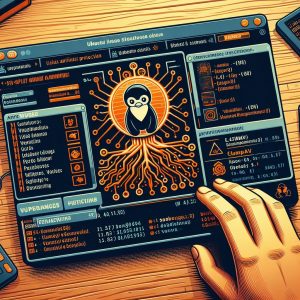
II. Understanding the Threat Landscape
Common assumptions regarding Ubuntu security require a reality check to avoid a false sense of safety. Mythbusting and evaluating new threats informs prudent self-defense.
Addressing Myths of Inherent Ubuntu Security
Conventional wisdom says Linux distributions like Ubuntu rarely suffer malware infections. But recent cyber campaigns dispel such complacency by actively targeting Linux servers including brute-force attacks on SSH logins, cryptocurrency miners implanted via scripting languages and systemd-level rootkits. OpenSSH backdoors, Linux.Encoder crypto-ransomware and SSHDoor botnets confirm Ubuntu servers operate on the cybercriminal radar.
Meanwhile on the Ubuntu desktop side, spyware strains like Hand of Thief and Crisis target bank account access via keylogging and form grabbing. Enterprise Ubuntu workstations face threats like ransomware-based file coders. Hence the barrier to threats on Ubuntu desktops and servers has eroded over the past decade.
Though Linux benefits from rapid open source patching for vulnerabilities and stronger permission controls limiting malware reach, judicious Ubuntu defense remains prudent as underestimating the evolving tactics still circulating may upend operations suddenly.
Emerging Infection Vectors
The Achilles’ heel for Ubuntu systems often stems from applications built atop Linux, rather than attacking the OS kernel itself. Vulnerabilities in PHP, Apache, OpenSSL and Node.js commonly offer initial intrusion vectors on Ubuntu servers. Cross-site scripting, remote command execution and SQL injection techniques provide piles of attack surface needling Ubuntu servers. Wily malware now bypasses even AppArmor security in Ubuntu when misconfigured. On desktops, web and email vectors including phishing downloads similarly plague Ubuntu users.
Hence rather than relying on base Ubuntu security alone, proactive analysis of the entire application stack running atop is necessary to lockdown and selectively sandbox risks using tools like containers. Ubuntu itself gives ground level hardening while supplemental methods tackle higher app layers generating attack paths. Antivirus solutions add another pillar for this crucial security-in-depth philosophy protecting strengths while offsetting weaknesses.
III. Available Antivirus Solutions
Many commercial antivirus platforms only support Windows, with some accommodating macOS too. But various corporate-oriented solutions specifically address Linux servers and Ubuntu for balanced effectiveness. Here are leading options:
Bitdefender GravityZone Business Security
GravityZone utilizes machine learning with memory introspection and anomaly analytics for detecting subtle Linux threats including ransomware, trojans, backdoors, crypto-miners and more without needing constant signature updates. GravityZone also sandboxes suspicious files in a secured cloud environment to efficiently test for advanced threats through deception tactics. For servers and VMs, GravityZone supplies out-of-the-box protection for Ubuntu and Debian with automated policies to enforce compliance.
Key Features
- Signatures, heuristics and behavioral analysis
- Integrated firewall, web advisories and vulnerability scanner
- Full scans and real-time memory monitoring
- Hypervisor integration securing VMs
Avast Antivirus for Linux
Avast applies decades of endpoint protection experience to the Linux environment for identifying threats that bypass native OS shielding. Partnered with IBM and Red Hat, Avast looks for anomalies around suspicious processes, unauthorized changes to system files and network traffic indicative of C2 communication. It defends various Linux distributions without compatibility issues or performance side effects.
Key Features
- Hardened web shield guarding against malicious sites
- Script scanning for Python, Bash, PHP malware
- Secured connections protocol
- Firewall and intrusion detection
ClamAV Open-Source Anti-Virus
ClamAV utilizes signatures and heuristics to detect trojans, bots, viruses and worms specifically targeting Linux. As an open source platform maintained by Cisco Talos, ClamAV signatures stay current with community support. High throughput on multi-core servers makes ClamAV suitable for large Ubuntu deployments across networks.
Key Features
- Detections for over 1 million malware variants
- Scheduled background scanning
- Automatic signature updating
- Email gateway integration
- Lightweight performance footprint
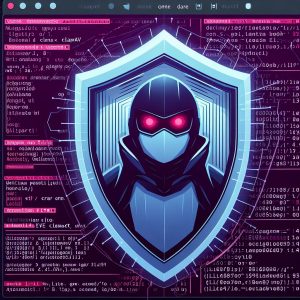
IV. Installation and Usage
Installing antivirus protection on Ubuntu leverages the APT software management system to seamlessly add security layers:
Prerequisites
Begin by updating packages on Ubuntu:
Next install ClamAV antivirus engine:
Usage
Check ClamAV version:
Run virus scan on entire filesystem:
Individual folders can also be scanned:
Review scan logs for detections:
cat /var/log/clamav/freshclam.log
Scheduling
Automate recurring scans with cron jobs:
# m h dom mon dow command
0 0,12 * * * clamscan --recursive --infected --remove /
This performs a complete system scan twice daily removing threats. Additional usage options exist to only scan new files, create exclusions, set file size limits and optimize scanning across multiple cores and servers. Integrations with Redis and Docker secure containers. Mail gateway plugins expand scope stopping threats arriving via email. Together this fortifies Ubuntu environments comprehensively.
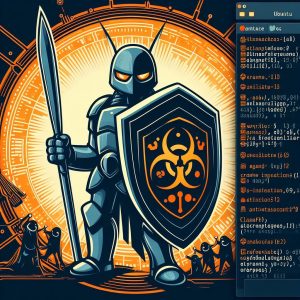
V. Recommendations and Best Practices
Securing personal and enterprise Ubuntu landscape requires holistic diligence with antivirus protection acting as an integral component.
Home Users
For basic Ubuntu desktop security:
- Maintain device patches up to date always
- Restrict installation of outside applications
- Review browser extensions access permissions
- Backup important data offline regularly
- Disable unwanted services to minimize exposure
- Enable firewall to filter suspicious traffic
Organizations
Business security teams supporting Ubuntu users, servers and cloud instances should:
- Standardize servers on Long Term Support Ubuntu builds only
- Integrate UFC vulnerability scanning
- Limit users permissions with least privilege
- Automate security updates streamlined to validate app compatibility
- Support Ubuntu Pro for security compliance features
- Strengthen SSH key-based authentication for remote access
- Install centralized antivirus management console to enforce policies
Carefully tailored precautions sustain trusted computing across cloud vantage points as threats mount against Ubuntu specifically.
VI. Conclusion
Despite assumptions, Ubuntu desktops and servers do face intensifying malware and virus dilemmas as adversaries purposefully exploit blind spots. Ignoring these risks jeopardizes stability. While Ubuntu itself promotes baseline hardening, applications layered above remain vulnerable awaiting additional security reinforcement. By combining intrinsic Linux security with robust antivirus suited specifically to Ubuntu’s technical composition plus sound user practices, both individuals and organizations can reap protection on par with commercial platforms while benefiting from Ubuntu’s speed and flexibility advantages. Antivirus fills a clear gap that should not be overlooked on Ubuntu because eventually infections numbers will continue rising to incentivize targeting. Staying vigilant and proactive means Ubuntu persists as a secure platform for computing duties across endpoints.
Introduction
Unlike Windows or macOS, Linux operating systems are virtually untouched by viruses or malware. In fact, some sources claim Linux is more immune to viruses than any other OS. But that is not entirely true—there are still threats, and you may want to consider antivirus software. The criteria analyzed here assess the real-time performance, overall protection level, program utilities, and ease of use that customers can expect for Linux solutions. Understanding antivirus options for Linux can help decide if a system requires extra security.
Linux servers power vast swaths of enterprise IT infrastructure. With 94% utilization in the public cloud and 90% of supercomputers, Linux runs the systems and sites businesses depend on. Meanwhile, Linux desktop usage continues rising across enterprises and consumer segments. Its increased role in critical functions means more extensive damage becomes possible if malware infiltrated a Linux system’s root access. Hence antivirus software plays an important role by adding extra assurance as users, data flow, and connectivity multiply on Linux.
Antivirus for Linux focuses more on signature-less heuristics combined with rootkit defenses instead of mammoth signature databases associated with Windows suites. The goal is to reinforce Linux’s inherent security advantages via process monitoring, abnormal filesystem changes and similar anomaly detection. Linux solutions must also operate lightweight to avoid hogging system resources in dense server deployments. Top Linux antivirus solutions maximize interoperability across environments with orchestration-friendly engines supporting containers, Kubernetes and microservices.

Key Features to Consider
Here are essential criteria to assess the quality and scope of Linux antivirus software:
1. Real-time Protection
Instant detection of malware and cyber threats is critical to prevent infections embedding into the system before detection. Capabilities like signature-less behavioral monitoring analyze processes in an always-on manner tracking insertion of rogue commands and subversion attempts. Integrations with vulnerability scanners further empower real-time security hygiene.
2. Firewall
A built-in firewall managing data traffic and filtering malicious or suspicious content is also valuable. Combining firewalling with antivirus reinforces Linux workloads through network traffic awareness. It should adapt policies per application risks and support orchestration templating.
3. Open-Source & Distribution Compatibility
Seamless support for open source platforms like Ubuntu, Debian and CentOS is vital along with maintaining Linux distro agnosticism to function correctly regardless of versioning differences. No proprietary dependencies or kernel customizations should exist. Container-friendly tools add value for cloud-native Linux.
4. Comprehensive Virus Scanning
Both real-time and on-demand scanning offers multidimensional detection strengths – the former to catch novel threats when initiated while the latter uncovers dormant infections through full system sweeps. Scanning reach across files, scripts and memory is key along with centralized visibility of security state.
Top Antivirus Solutions for Linux
Below are leading corporate-grade Linux antivirus systems with accompanying pros, cons and descriptions:
1. Bitdefender GravityZone Business Security
Pros: Flawless malware detection rate with low false positives, protection for physical servers, VMs and containers, built-in firewall and intrusion prevention
Cons: Advanced features require paid subscription
Summary: GravityZone Business Security brings enterprise-grade threat prevention to Linux systems with virtual patching, exploit mitigation and robust malware analytics. Behavior-based blocking and anti-ransomware secure data integrity.
2. Sophos Intercept X
Pros: Specialized server security, capable rootkit detection, crypto-mining malware protection
Cons: Steep learning curve for configuration
Summary: Intercept X for Server reinforces Linux workload security with signature-lessdeep learning malware models securing AWS, Azure and on-premise infrastructure.
3. Bitdefender Antivirus Plus 2020
Pros: Lightweight performance impact, consistently high detection rates, multi-platform support
Cons: Limited centralized management capabilities
Summary: Hardened malware and phishing protection for Linux desktops and servers featuring web attack prevention, privacy firewall and integrated Patch Management.

4. Kaspersky Embedded Systems Security
Pros: Secures specialized appliances and IoT devices based on Linux without desktop overhead
Cons: Focused exclusively on embedded Linux
Summary: Ultra-light security engineered for network gear, industrial systems and hardware appliances leveraging Linux, from ATMs to telecom routers.
5. Malwarebytes Incident Response
Pros: Cloud-based management for mass endpoint deployments, incident response retention policies
Cons: Requires cloud subscription and lacks hosted dashboards
Summary: Scalable carrier-grade virus detection supporting MSPs, MSSPs and enterprise SOCs defending large Linux endpoint fleets with backup malware scans.
6. McAfee Endpoint Security
Pros: Longstanding industry leader in Linux antivirus, open source optimized threat intelligence
Cons: Intensive resource consumption
Summary: Battle-tested signature-powered malware removal securing Linux systems with customized offline scanning, encryption and preemptive threat analytics.
7. Avast Ultimate
Pros: Free for personal usage with paid tiers for expanded capabilities, user-friendly interface
Cons: Underperforms against advanced malware threats
Summary: Straightforward antivirus solution for Linux desktops balancing usability with core signature malware protections, though detection rates visibly trail top corporate suites. Ideal for students, freelancers and basic home usage.
Installing Antivirus Protection on Ubuntu
Installing antivirus software on Ubuntu, a popular Linux distribution, typically involves two main tools:
1. ClamAV Anti-Virus
ClamAV is a widely trusted open source antivirus engine for detecting Trojans, viruses, malware and other threats using heuristic signature scanning optimized for Linux performance. It is licensed under GPL and available freely including source code.
2. CLamTk Graphical User Interface
CLamTk offers an optional graphical front-end to manage ClamAV giving users an intuitive interface to configure scan settings, view threats detected, quarantine infected files and review logs without needing the Linux command line.
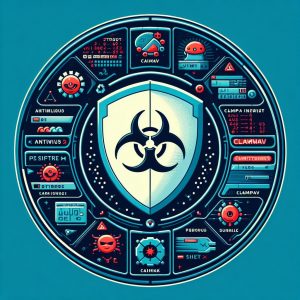
3. Installation Process
Here are the basic steps to set up ClamAV with CLamTk on Ubuntu:
- Run system update:
sudo apt update && sudo apt -y upgrade
- Install ClamAV:
sudo apt install clamav
- Start ClamAV daemon:
sudo systemctl start clamav
- Install CLamTk:
sudo apt install clamtk
- Launch CLamTk app or run clamscan CLI
- Review logs at
/var/log/clamav
- Schedule cron jobs for recurring scans
This makes ClamAV constantly run protection in background and CLamTk allows launching manual scans with visual management. Additional fine-tuning like exclusions, memory limits, multi-threading and mail server integration further builds out security.
Conclusion
Antivirus solutions offer important supplemental security for Linux in the expanding threat landscape consisting of not just viruses but also sophisticated malware strains aimed at covertly subverting systems and infrastructure for cybercrime, chaos or espionage. Evaluating options specifically designed for Linux without Windows baggage provides optimal protection.
Capabilities to weigh include real-time heuristics defending workloads through anomaly detection, firewalling to filter dangerous traffic, seamless integration across distros, environments and versions along with comprehensive scanning reach into entire systems. This well-rounded antivirus security layers on vital reinforcement for production Linux underpinning apps, data and services while maintaining the performance efficiency which makes Linux attractive for security-first organizations. Implementing Linux-compatible suites sustains trusted computing as threat actors increasingly probe for weaknesses.
I. Introduction
Intego is a Mac-focused cybersecurity company that develops antivirus and Internet security software designed specifically for Apple devices. Intego Antivirus has provided protection to Mac users for over 20 years. Its software aims to safeguard Macs with advanced anti-malware technology and extra utility tools in one comprehensive package.
With the rise in macOS threats in recent years through new malware strains, phishing attacks, and vulnerability exploits, Apple-tailored security has become increasingly vital. Mac users can no longer rely on the operating system’s built-in protections and require layered security. Intego Antivirus fills this need with specialized Mac capabilities for individuals, families and businesses.

II. Features of Intego Antivirus
Intego Antivirus provides robust malware protection along with various Mac computer enhancements:
Strong Anti-Malware and Virus Capabilities
The cornerstone of Intego Antivirus is the VirusBarrier component which leverages signature-less scanning to proactively block zero-day threats along with recognizing new variants of known Mac malware families. It can detect backdoors, spyware, keyloggers, bots, adware, ransomware, and more.
Both manual and scheduled scans are offered to actively check for dormant infections along with real-time detection of any malicious downloads or app launches. Suspicious apps are automatically blocked from installation or execution to prevent infiltration.
An quarantine space securely contains any malware threats detected until reviewed or removed by the user or administrator. Overall, independent lab testing verifies Intego’s anti-malware proficiencies placing it among the top Mac antivirus solutions.
Comprehensive Parental Controls
Intego includes rich parental control functionalities through its ContentBarrier tool aimed at families. It allows parents to restrict access to inappropriate websites using category-based content filtering spanning millions of pages. Age appropriate filtering can be enabled for kids and teens.
Network activity monitoring shows sites being accessed on a timeline along with chat conversations within allowed apps. Remote device screen time scheduling promotes healthy limits and balanced media consumption by children monitored from the parent’s system.
Together the parental control toolkit enables safe web surfing and device usage for youths under guidance customized to a household’s requirements. For example, gaming sites can be allowed but social networks disabled as needed per age policies.
User-friendly NetBarrier Firewall
Intego provides extensive inbound and outbound firewall protection through an intuitive interface named NetBarrier tailored specifically for Mac platforms. At its core, NetBarrier offers a set of granular network traffic filters controlling connections to and from apps using a positive security model.
For example, users can allow a vulnerable browser version to only contact the vendor’s update servers while blocking all other traffic. Advanced users can open firewall logs showing all network events like blocked and allowed connections for security analysis. Further custom rules can be created using parameters like port, IP address, protocol and bandwidth allotments.
NetBarrier makes firewall security accessible even for Mac consumers without networking expertise through clear visualization of app network behaviors. Controls drive sound safety practices and data privacy for everyday users.

Personal Backup Functionality
The Vault component of Intego Antivirus enables simple backups of important documents, media files and folders on a schedule or on-demand to preserve data backups. Storage space up to 2 GB is included or external drives can be utilized as backup destinations for flexible capacity.
Backup settings allow for comprehensive or targeted file selection along with scheduling for routine safeguarding of critical data against accidental deletions or emerging drive issues before loss. Email notifications confirm backups for reliability auditing while version histories support reverting from earlier archives if needed.
Mac Specialized Device Optimization
Intego builds a Mac-specific system optimization tool called Mac Washing Machine into its security suite as an extra advantage over Windows-inherited antivirus platforms. Mac Washing Machine cleans up unnecessary clutter and frees up drive space by removing gigabytes of useless junk files, language files, universal binaries, obsolete files, and system logs from macOS.
It identifies apps hogging battery life along with tracking installations and alterations to offer a detailed map of the systems state over time. Additionally, Mac Washing Machine can monitor CPU, disk and network usage spikes to troubleshoot performance problems or uncover suspect background activity indicative of malware.
Bringing native optimization attuned to macOS generates a more responsive, stable and secure computing environment benefitting the antivirus protection itself and the system’s operations overall.
Additional Security Features
On top of its core personal protections, Intego Antivirus includes supplementary capabilities sought by discriminating users:
- Email shield against malicious attachments and phishing links
- SMS/iMessage spam filtering using whitelist/blacklists
- Suspicious email forwarding to security provider sandbox analysis
- Reporting showing app internet usage metrics for tracking and control
- Surfing protection to prevent adware, spyware and drive-by-downloads
- Auto-lock functionality for associated kids’ devices during allowed usage-periods
Together these construct a private and secured digital experience personalized to safeguard modern lifestyles on Mac devices. Even basic subscriptions of Intego Antivirus gain advantages from these integrated offerings.
III. Pros and Cons
Intego Antivirus offers intriguing strengths but also comes with a few limitations to weigh for one’s specific needs:
Pros
- Excellent Anti-Malware Testing Results: Intego earns top scores from AV-TEST and AV Comparatives for malware protection efficacy on Macs surpassing most solutions. Its signature-less and heuristic monitoring competently combat Mac threats.
- Manual and Scheduled Scanning: Users can run instant checks for stealthy infections along with configuring daily or weekly recurring scans to remove dormant malware missed during real-time detection.
- Mac-Tailored Feature Set: NetBarrier firewall, personal backup, parental controls and optimizations like Mac Washing Machine cater capabilities to Mac environments lacking in cross-platform offerings.
- Light System Impact: Intego maintains high processing standards for MacBooks and iMacs with minimal slowdowns even during active scanning based on user reports. Its clean interface avoids overwhelming users.
Cons
- No Real-time Scanning in Basic Tiers: Missing modern baseline feature expected in premium software despite strong lab scores. Real-time protection requires purchasing higher-tier bundles.
- Limited Anti-Phishing Capabilities: Core emphasis resides on malware removal rather than sniffing out phishing lures which remain abundant on Macs. Lacks financial fraud alerts.
- Email Integration Gaps: Cannot plug directly into Apple Mail or Microsoft Outlook to filter spam and malicious emails at the client source. Relies on standalone shield component.
- No Mobile Protection: As a Mac solution, Intego leaves iOS and iPadOS devices unprotected. Fortifies macOS endpoints only.

IV. Additional Functionality
Beyond expected antivirus basics, Intego adds bonuses like Mac Washing Machine utilities that optimize and monitor Mac systems at a deeper level. These extras secure the user experience in meaningful methods other providers overlook.
For instance, Mac Washing Machine cleans storage wasted by useless system junk bloating devices over time. Recovered capacity indirectly improves performance and stability. As Macs heavily fragment drives, periodic optimization becomes critical yet Apple lacks native tools to deeply defrag directories, purge wasteful language packs unrelated to the region, or remove years of outdated binaries and logs clogging directories.
Mac Washing Machine fills the gap to streamline macOS maintenance. It can rollback troublesome system changes by apps gone rogue. Performance bottlenecks aroundCPU, disk or network spikes manifesting due to malware misuse also become visible for diagnosis and resolution.
Such holistic insights into Mac state generates awareness normal scanning misses for better resilience and usability. It demonstrates Intego’s specialization in tailoring utilities precisely for Apple ecosystem defense rather than just porting a Windows product over.
V. Expert Insights
Josh Long is Chief Security Analyst at Intego, overseeing research into Mac and iOS threats to guide the company’s security software strategy and roadmap. With decades of experience investigating malware campaigns, vulnerability disclosures and patching processes across operating systems, Long provides perspective on risks facing Apple users.
A common misconception Long highlights is the notion that Macs are largely immune to malware, thereby needing little protection. In reality, major attack waves have actively targeted macOS consistently including Flashback, Crisis, CoinThief, MacMaiba and OSX.Dok infections raiding encrypted user data, mining cryptocurrency stealthily, hijacking browsers with backdoors and spying via screen captures.
The threats remain persistent and evolving. For instance, in 2021 a surge of Shlayer malware infected upwards of 30% of Macs aiming to sneak adware with sophisticated defenses against removal. Long notes these samples evaded Apple’s own Malware Removal Tool proving deficiencies in native protections, unlike Windows where Microsoft Defender raises the base security bar significantly.
The paradox Long observes is that Apple’s tight control of macOS and App Store ecosystem curtails certain attack vectors but also slows adoption of modern security features for directly combating threats on endpoint devices themselves. Macs urgency cloud-based malware analytics, behavior monitoring and real-time memory scans rivaling Windows 10 and 11 counterparts.
Apple maintains Macs need little additional utilities despite clear threats going unaddressed. Hence Long believes Mac users should evaluate dedicated solutions like Intego Antivirus specialized for Apple environments yet unconstrained by Apple’s sluggish security advancements.
Introduction
Fortinet’s FortiGate firewall includes an integrated antivirus engine as part of its security capabilities. FortiGate Antivirus provides protection against viruses, malware, ransomware, and zero-day threats for networks. It leverages technologies such as flow-based inspection, proxy-based inspection, cloud-based analysis with FortiSandbox, and the FortiGuard antivirus service to detect threats.
Implementing antivirus at the network layer is an important element of an organization’s cybersecurity strategy. Antivirus inspection at the gateway firewall can detect threats before they enter the network and spread to devices. Additionally, central management of antivirus from a firewall consolidates administration and policy deployment. Overall, FortiGate Antivirus offers robust threat detection to safeguard networks with low latency impact.
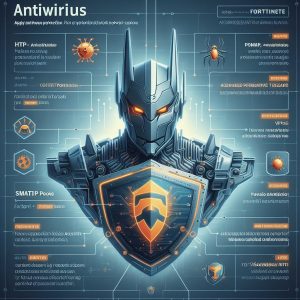
FortiOS Antivirus Features
FortiOS, the operating system of FortiGate firewalls, contains extensive antivirus capabilities:
Flow-based and Proxy-based Antivirus
FortiGate firewalls perform antivirus inspection in flow-based and proxy-based modes. Flow-based scanning analyzes network traffic transparently without proxying sessions. Proxy-based scanning proxies traffic so content can be fully decoded before inspection.
Administrators can configure custom policies determining which traffic goes through each mode for optimal performance and security. Proxy-based inspection offers the highest detection rate but also consumes the most resources.
Preconfigured Antivirus Profiles
FortiOS comes preconfigured with default profiles for antivirus inspection including default and wifi-default profiles. These contain optimal settings for networks and wireless access points. Additionally, administrators can fully customize profiles to match an organization’s requirements.
Customizable Inspection Rules
Within antivirus profiles, administrators have granular control to tailor security policies. Settings can be configured for:
- Inspection of protocols such as HTTP, FTP, SMTP, and more
- File size limits for scanning
- Blocking, monitoring, or allowing infected code
- Removal of viruses via heuristics
- Analysis with FortiSandbox
- Protection from botnet communication and callbacks
FortiSandbox Integration
FortiGate integrates with the FortiSandbox appliance, Fortinet’s advanced threat analysis sandbox. Suspicious files traversing FortiGate are sent to FortiSandbox for deeper inspection using techniques like emulation and behavioral analysis. The FortiSandbox database provides an added layer of cloud-based protection.
FortiNDR Inline Scanning
FortiGate also integrates with FortiNDR, Fortinet’s network detection and response platform. This allows for inline scanning of network traffic by the FortiNDR threat intelligence database in addition to FortiOS antivirus capabilities.
Exempt List
For files that generate false positives, FortiGate allows creating an antivirus exempt list to exclude files from scanning based on checksum. This prevents repetitive quarantining of clean files.
Quarantined File Download
Any files or code quarantined by antivirus inspection can be conveniently downloaded by administrators in password-protected archive format for review and analysis.
Profile Testing
Within FortiOS, administrators can upload samples of malware to securely test if an antivirus profile properly catches threats as intended. This verifies efficacy before deploying the profile into production.
FortiGuard Antivirus Service
Central to FortiGates antivirus capabilities is the FortiGuard antivirus service. This cloud-based service from Fortinet provides continuous updates that protect networks from the latest threats:
Broad Protection
FortiGuard offers wide security against malware, viruses, Trojans, worms, spyware, botnets, ransomware, and zero day attacks that may bypass traditional signature-based detection. The FortiGuard team closely monitors threat landscape globally for emerging attacks.
Content Pattern Recognition
Using proprietary algorithms and data science models like patented Content Pattern Recognition Language (CPRL), FortiGuard identifies new threats extremely quickly, often within seconds of outbreak. This allows immediate protections to be deployed to FortiGate firewalls globally.
Machine Learning and Signatures
The FortiGuard antivirus service uses machine learning techniques along with traditional signatures to catch threats. The combined approach ensures maximum detection of both known and unknown malware. Signatures remain essential for recognizing variants of known malware families.
Sandbox Integration
Fortinet sandwiches FortiGate between powerful tools on both sides as FortiGuard pairs with integrated FortiSandbox sandboxing. Network files can be inspected by multiple analytics systems simultaneously for uncompromising security.
Broad Platform Support
FortiGuard supplies threat intelligence for Fortinet products across the entire digital attack surface including firewalls, web applications, email, endpoints, servers and more. This allows coherent security policies across IT, OT and converged environments.
Endpoint Protection
Fortinet also offers FortiClient endpoint software leveraging the same FortiGuard threat intelligence as FortiGate firewalls. Teams can deploy antivirus with matching detection profiles across networks for harmonized cross-product protection.

FortiOS Antivirus Inspection Modes
FortiOS antivirus protection utilizes two primary inspection modes:
Protocol Comparison
Below are key differences between flow-based and proxy-based inspection:
| Criteria |
Flow-based |
Proxy-based |
| Performance impact |
Lower |
Higher |
| Latency added |
Minimal |
Increased |
| Detection rate |
Moderate |
Maximum |
| Supports SSL inspection |
No |
Yes |
| How traffic is processed |
Transparent, non-proxy |
Proxy, decode content |
Protocol Support
FortiGate antivirus scans the following protocols:
- HTTP, HTTPS
- FTP, FTPS
- SMTP, SMTPS
- POP3, POP3S
- IMAP, IMAPS
- MAPI over HTTP
- CIFS
- SSH
- NNTP, NNTPS
Additionally, proxy-based inspection can be applied to user-defined applications and protocols for customized security.
FortiGate Antivirus Configuration
Fortinet allows extensive customization of antivirus profiles deployed to FortiGate firewall policies including:
AI-based Malware Detection
Machine learning and artificial intelligence can be enabled to detect malware patterns beyond traditional signatures. This probes deeper including analyzing code frequency, injections, encryption, obfuscation and polymorphism.
Antivirus Testing
Within FortiOS, sample malware files from Fortinet’s repository can be downloaded to test FortiGate’s integrated antivirus scanner against new threats. The system will provide a report with the detection result for profile tuning.
FortiOS Best Practices
Follow these guidelines when enabling FortiGate antivirus for optimal security and performance:
Maintain FortiGate
Always ensure antivirus signatures and firmware remain updated on FortiGate to catch latest threats with high efficacy. Schedule regular automated FortiGuard updates along with system vulnerability scans.
Select Necessary Protocols
Only enable antivirus scanning on the required protocols instead of blanket enabling all traffic inspection. Start with highest risk protocols first like HTTP, SMTP then expand accordingly. This prevents performance decline from unnecessary scanning.
Consider File Size Limits
Set conservative file size limits between 2 to 10 MB maximum on antivirus inspection rules. This reduces degrade from scanning extremely large files while maintaining safety. Video streaming and backups may be exempted from antivirus inspection entirely.
Monitor Quarantines
Review FortiGate’s quarantined files regularly to understand targeting threats and identify false positives to add to exempt list. Quarantined malware can be submitted to FortiGuard as new samples to improve detections.
Tune Logging
Avoid logging every single antivirus event which can quickly consume storage space. Focus logs on critical severity detections with traffic filters to capture required incidents. Forward logs to a SIEM for correlations and dashboarding.
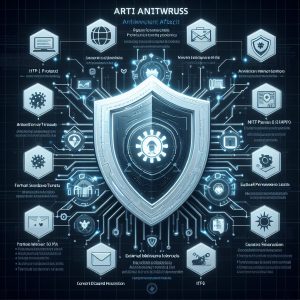
Minimize Inspection
Only enable security inspections like antivirus, IPS, and application control where explicitly needed instead of all traffic. This minimizes resource usage while allowing masking (NGFW mode) for positive security models and zero trust segmentation.
Consolidate Alerts
Set threshold counts and time durations along with event suppression rules to reduce repetitive alerts from the same infection vector. Alert storm protection is available in FortiOS 6.0 and above. Funnel alerts into reliable monitoring and response workflows.
Schedule Updates
Configure scheduled updates from FortiGuard servers to provide new antivirus definitions automatically as Fortinet release them to counter fresh threats. Include secondary update server for high availability.
Maintain Firmware
Stay current on FortiOS firmware updates which may bring antivirus detection improvements along with critical security patches and stability fixes. Test releases in staging environments first then progress to production.
Enable Services
Confirm FortiGuard antivirus and IPS services are enabled in the Fortinet support portal with valid licenses for full threat definitions from Fortinet’s research labs as updates emerge.
Conclusion
FortiGate firewalls include industry-leading antivirus inspection integrating multiple technologies like cloud analytics, sandboxing and machine learning to protect against malware threats targeting the network edge. Centralized control from FortiOS also simplifies policy administration and response workflows. With customizable profiles and extensive protocols support matching modern application traffic, FortiGate antivirus keeps organizations secure through proactive threat prevention. IT teams are advised to follow best practices and tune configurations for optimal efficacy through a harmony of performance and security within networks.





























